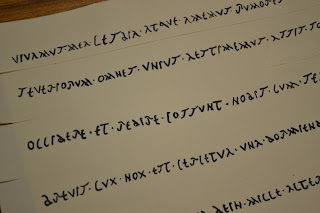Calidorus: Cape has tabellas, tute hinc narrato tibi quae me miseria et cura contabefacit.
Pseudolus: Mos tibi geretur. Sed quid hoc, quaeso?
Calidorus: Quid est?
Pseudolus: Ut opinor, quaerunt litterae hae sibi liberos: alia aliam scandit.
Calidorus: Ludis iam ludo tuo?
Pseudolus: Has quidem pol credo nisi Sibylla legerit, interpretari alium posse neminem.
Calidorus: Cur inclementer dicis lepidis litteris lepidis tabellis lepida conscriptis manu?
Pseudolus: An, opsecro hercle, habent quas gallinae manus? Nam has quidem gallina scripsit.
Calidorus: Take these tablets, then tell yourself what miserable worry is wasting me away.The Romans themselves knew that their handwriting was a challenge to read, and that is what our Latin 5/6 students have been exploring as they pursued a bit of paleography, or the study of ancient writing. We began be discussing the different feeling a person gets from reading the same text in different fronts. To facilitate this, I distributed copies of familiar Latin poems printed in a variety of modern fonts. Students quickly and firmly voiced opinions as to which fonts fit which poems better, or which were total disasters.
Pseudolus: I'll do this for you. But what is this, I ask?
Calidorus: What is it??
Pseudolus: In my opinion, these letters want children for themselves: one mounts the other.
Calidorus: Are you making fun with your mocking?
Pseudolus: Indeed, by Pollux, I believe that unless the Sibyl can read these letters, nobody else can understand them.
Calidorus: Why do you speak harshly about these charming letters and charming tablets, written by a charming hand?
Pseudolus: By Hercules I beg you, what hands do hens have? For indeed a hen wrote these letters.
From here we explored the style of writing known as Old Roman Cursive. Here is an example, which just happens to be the oldest preserved example of a woman's writing in Latin.
The students study writing materials as well and then make their own papyrus sheets and calami (reed pens) or tabellae (wax tablets) and styli (styluses). With these they copy a text of their choosing using the Old Roman Cursive alphabet. They submit this with a paper discussing the challenges they faced in learning to read and write ORC and making and using the ancient writing implements. They must also discuss insights they gained into the practice of Roman writing.
Below are some pictures from last year's efforts because this year's pictures did not turn out well. The students' work, however, was of the same, high quality.






No comments:
Post a Comment